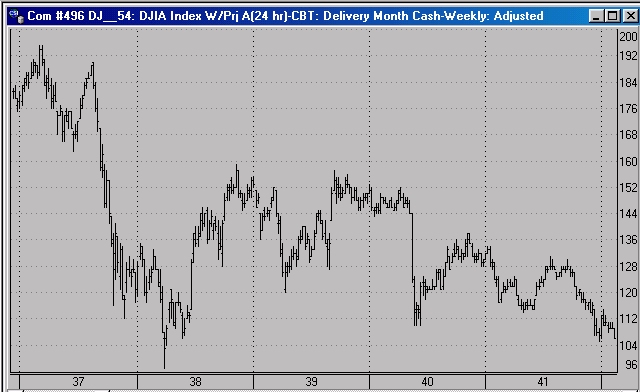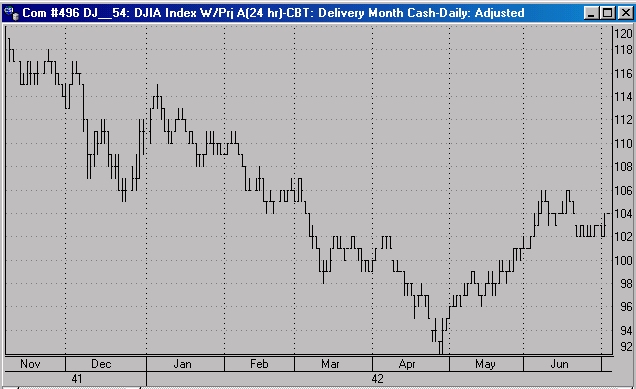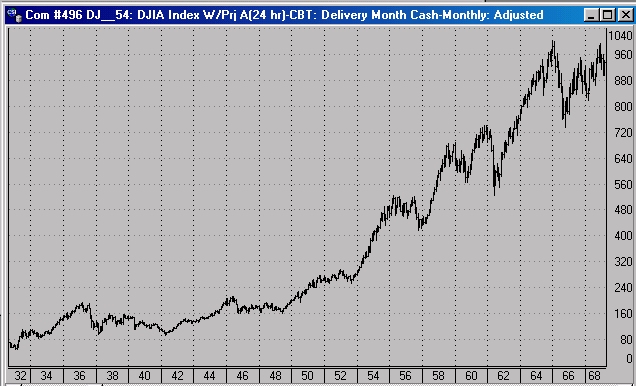| Monthly
Article
Topics for October |
||
|
This Issue
Various Topics
Tech Talk
Market Statistics
Notice:
Copyright (c) 2001 Commodity Systems Inc. (CSI). All rights are reserved.
|
Topics discussed in this month's journal.
Our thoughts and prayers are with the victims of the terrorist attack on America. All of us at CSI send our condolences to our many customers and friends affected by this tragedy.
Pearl Harbor Revisited? September 11th was the deadline for the first draft of this article, which could not escape being shaped by the unimaginable events of the day. As the U.S. prepares to fight a cowardly secret enemy, each of us is wracked with a myriad of emotions. Images of horror, heartbreak, bravery and courage flow from the television screen and, at moments when my attention strays from this unfolding human tragedy, I wonder what the future may bring. The events of September 11th prompt me to remember another dark day for Americans and to ponder the question of how the U.S. and world markets will react to an unprovoked attack on America. History tells us that the only event vaguely similar to this occurred on December 7, 1941, the "date which will live in infamy," when Japan bombed Pearl Harbor. I reviewed some charts of the era to see what was going on with the Dow Jones Industrial Average® back before December 7th 1941, and how it responded in the years that followed. The DJIA (CSI #496) was experiencing downward pressure from mid 1937 to 1941, when the value moved from a high of 187 to a low of 104, but generally oscillated in a range of 110 to 150. On December 8th 1941, the day after the U.S. was attacked by Japan, the Dow Jones Average closed at 112, down 4 points (3.4%) from the previous Friday's close (see figure 1). Figure 1 © CSI Unfair Advantage I vividly remember December 7th when Pearl Harbor was attacked. It was a cold drab day in Toledo, Ohio when my parents and I were driving home from church. There was a boy on a street corner selling newspapers. "Extra!, Extra! Read all about it; Pearl Harbor bombed in a sneak attack on Hawaii." My father bought a paper, then announced that he would have to go to war. I was 8 years old at the time. Five months after the attack and the United States' subsequent entry into World War II, the Dow Jones Average had dropped 21% from pre-war levels to 92. This was a low not visited since 1934 when I was an infant, and not seen again in the 59 years hence (figures 2 and 3). Figure 2 © CSI Unfair Advantage Figure 3 © CSI Unfair Advantage
Following
the percipitous drop of 1942, the war effort gained momentum and the aggressive
U.S. economy pushed the Dow Jones Industrial Average up to around 1000 by 1966.
Although there is absolutely no solace in the prospects of market recovery at
the expense of war, the people pulled together to combat a hostile enemy, and
the Dow moved to ever-higher levels until the end of the century.
Bob Pelletier
Unfair Advantage's Adjustments in Action Our apologies for unavoidable delays in data delivery on September 11th - 13th. A unique feature of the Unfair Advantage historical database is that it is not fixed or stagnant. The visible database can be remotely adjusted through changes made at our office that allow everything in your portfolio to maintain continuity with current exchange conventions. The adjustment file (called UA\ARCHIVES\cdbadjst.adm) holds multipliers to adjust for changes in contract size, trading units or other contract specifications. For example, the point value for the S&P 500 (CSI #149) has changed during the life of the series and UA's adjustment file (cdbadjst.adm) holds a line for #149 that reflects this change. It has to do with doubling volume and open interest readings prior to 19971031 because of a change in contract size from $500 to $250 per point. The entry in the adjustment file is a scaler designed to blend one series with another to produce a longer continuous series when back-adjusted contracts are created. This would also proportionately change the prices of the resulting combined series and would force the output back-adjusted series to differ from the input. The CSI staff is diligent about maintaining the adjustment file, and may make changes for a variety of reasons. Our efforts allow customers to see extensive historical information for any given market. We are in the process of showing oil and gasoline prices back before World War II through a database we acquired involving well head prices. Such data will soon be blended into our energy series to give UA customers greater historical perspective for econometric studies. The adjustment file will undoubtedly be called into play. We recommend
that adjustments be applied to the database as needed, and therefore have made
this the default selection in our software. If you do not wish to use the
adjustments, please go to the "Historic Adjustments" tab of Portfolio Settings
and uncheck the "Apply adjustments." box.
Compatible Software Profile: Elliottician (Makers of Elliott Wave Analyzer) From time to time in this Journal, we print information about companies offering products that are compatible with the CSI Data Retrieval Service, or whose services might be of particular interest to our customers. This month we will highlight Elliottician, makers of the popular Elliott Wave Analyzer systems. When The Elliott Wave Analyzer was released back in 1995, it was the first software package to apply the Elliott Wave Principle to trading. The author of the software, Richard Swannell, worked extensively with Bob Prechter of Elliott Wave InternationalT (http://www.elliottwave.com ) to produce an accurate representation of the thousands of rules and nuances of the Wave Principle. More than 4,000 traders now use this package. Richard Swannell trusts Unfair Advantage exclusively as his own data vendor of choice, both for the continuing development of The Elliott Wave Analyzer, and in his own trading. He states publicly that CSI's reliability and accuracy is unsurpassed, and recommends CSI to all his clients. A special CSI version of The Elliott Wave Analyzer II is available for free download and trial. It also includes a free Basic Edition, and can be downloaded directly from the Internet at ftp://216.188.35.35/EWA2UA.exe. For more information, go to http://elliottician.com with your browser.
PAGE 1
|





